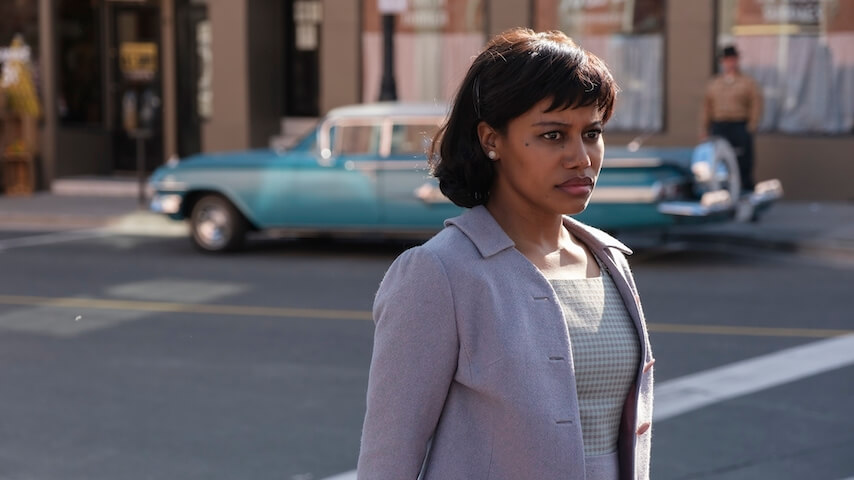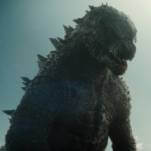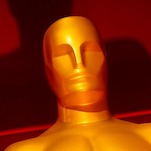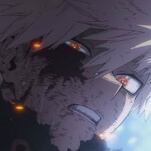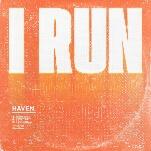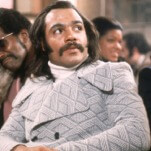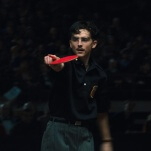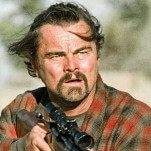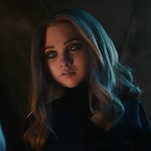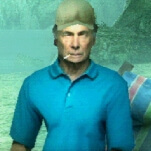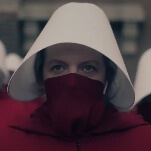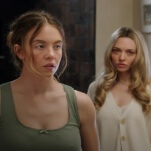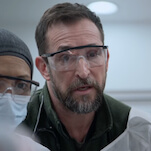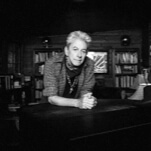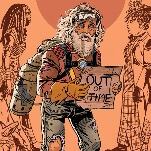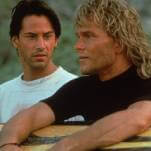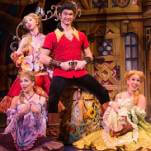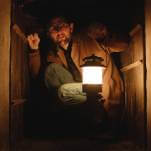[Editor’s note: This recap coincides with episode two dropping on HBO Max on October 31. Recaps will return to a Sunday schedule with episode three on November 9.]
If you take them strictly as a pair of recipes, the first and second episodes of HBO’s Welcome To Derry look a lot alike: You’ve got a couple of big, grotesque set pieces (one significantly more effective than the other). You’ve got some mixed performances from the younger members of the cast. And you’ve got a bifurcated plotline that struggles mightily to bring the two halves of the show’s brain into conversation. So given those base similarities in their constituent parts, why is “The Thing In The Dark” a pretty good episode of television, while “The Pilot” was outright lousy? It’s the cruelty, folks.
Which is to say that, while the premiere seemed mostly content to poke a stick at easy Stephen King signifiers as it trotted along toward its big, twisty bloodbath, “The Thing In The Dark” begins tearing into those aspects of the author’s work that continue to make IT such a compelling, queasy read nearly 40 years after its publication. Most especially, it begins peeling the skin back on the casual, cruel complicity of the people of Derry when it comes to awful things happening around them, whether those ugly moments come in the form of extreme instances of bullying or those terrible child murders that keep happening every 27 years or so. There’s nothing to be done about it, of course. Boys will, after all, be boys.
Austin Guzman’s script gives us a brand new character to serve as a window into all this ugliness-peeking-out-from-behind-the-blinds action: Charlotte Hanlon, wife of Leroy, who’s played by late-coming series star Taylour Paige. Paige’s presence in the episode is another reason this is a significantly better hour of TV than last week’s: The layers of reserve she holds in her eyes with every interaction with the perfectly pleasant (and perfectly monochrome) people of Derry tells volumes without ever having to spell things out—or force the other shoe to drop. Paige, and the show, know we’re primed for certain things to happen when we watch a scene of a Black woman walking on her own in a small, aggressively white town in 1960s America. Instead of going great for the jugular, though, the show teases us with moments when the turn might come, shooting each new approach to a potentially hostile Derry-ite like a horror film in miniature. (An early feint sees a car of hooligans yelling and apparently getting ready to hurl an egg at our heroine—only to reveal they’re actually pissed about the town’s big, ugly Paul Bunyon statue.)
When the ugly moment comes, though, it has nothing to do with race—because the thing lurking in Derry’s heart is a surprisingly egalitarian predator. No, what IT gets off on is weakness, as Charlotte sees a crew of older boys pounding a younger one into pulp in the middle of a major thoroughfare, while the adults of Derry (including genial butcher Stan “Stanley Cleaver” Kersh) happily look on. It’s Charlotte’s inability to tolerate injustice, not the color of her skin, that piques the town’s ire, nicely subverting early thoughts on where this story might be headed. It’s not like there aren’t any racists in Derry, obviously: We see lots of ominous looks get tossed at Dick Hallorann and his buddies at a local drinking hole later on, to say nothing of the speed and ugliness with which the forces of “polite society” seek to pin the theater deaths on Black projectionist Hank Grogan. But the scary thing about Derry, Maine, isn’t that its residents are secret Klan members: It’s that they’re perfectly pleasant, totally normal people, who will smile and nod along while the strong messily devour the weak right before their eyes. Boys will be boys!
It’s these moments of steadily ratcheting injustice that curdle the blood far more than the episode’s big grossout ones—which isn’t to say that the first it shows us tonight, when IT tears into Ronnie Grogan’s fears about her mother’s death during her own birth, isn’t a doozy. I don’t entirely love how director-executive producer Andy Muschietti shoots and conceives of these big sequences where IT tips its claw to its victims, presented with a taste for Grand Guignol excess that often threatens to render the whole thing excessively goofy. (It’s hard to explain exactly, but it’s something in the difference between the genuine, visceral horror of revealing that Ronnie, having clawed her way out of her faux-mother’s stomach, is still connected to the monstrosity by an umbilical cord—and the eyeroll that comes with the realization that the Caesarean wound she’s now being dragged back toward has big, stupid-looking teeth.) But the slow burn descent into nightmare is an effective one, and the sheer horror the scene piles on Ronnie as her sheets transform into a bloody stomach is suitably overwhelming. (It’s certainly much better than the late-episode set piece that sees Lilly Bainbridge playing peekaboo with Pennywise in the grocery store. I’m not saying you can’t make a monster made out of pickles scary, simply that Muschietti has failed to do so here.)
But it’s worth noting that the hour’s most unsettling sequences have nothing to do with gnashing womb teeth or pickled dad pates and everything to do with the subtle twisting of bad ideas in people’s heads. It’s in the eyes of teen girls as they watch each other carefully for signs of too much weakness or too much strength. It’s in the sound of their unwanted, hateful game of pattycake dominating the soundtrack as Ronnie fruitlessly begs Lilly to save her dad. It’s in the supposed kindness of police chief Clint Bowers, as he subtly threatens to send Lilly back to mental hospital Juniper Hill if she doesn’t give in and finger Hank Grogan for her friends’ deaths. It’s in the leering smiles of the orderlies at the asylum after she ends up getting dragged back there anyway, while her mother refuses to even acknowledge the horrors she’s inflicting on her child. Welcome To Derry doesn’t have the confidence to forego its grossouts entirely—and it would lose a crucial, if over-the-top, aspect of its identity if it did—but it does have the self-awareness to know that a single facial expression can be worth a thousand nightmare clowns.
“The Thing In The Dark” is, by no means, a perfect episode of TV. The show still has no clue, for instance, how to marry the Air Base plot to its wider story despite now having members of the Hanlon family situated strategically in both the town and the school. Meanwhile, that story is just full-blown whackadoo, as General James Remar reveals that he’s using Dick Hallorann’s Shine to find and weaponize something that sounds like it might be IT itself in order to beat those dang Ruskies and win the Cold War. (Don’t worry: Leroy has a damaged amygdala from Korea, rendering him The Man Without Fear, so he’ll be the perfect pilot to launch the Pennywise Nuke.) There are good moments in this half of the show’s severed brain, most especially the sequence where Leroy susses out that his attackers from last week couldn’t have been a racist dumbfuck like Chad Rook’s Masters. But god does it feel silly and out of place with anything else happening in this show.
Still, it’s a marked improvement, at least in part because of that continued focus on the Hanlon clan. (Son Will is a fairly stock “dweeb with a quirk,” befriending Reggie in detention, and getting lightly bullied by classmates. But Paige’s Charlotte is a breath of fresh air.) Last week, when I dinged Welcome To Derry for not trying to be about anything besides “Hey, you liked those two IT movies, right?” this was exactly what I was hoping to see. Fingers crossed that this is the start of a trend, as the season dispenses with the deadweight, and gets down to the actual (and far more interesting) business of real horror.
Stray observations
- • An odd, and extremely brief cold open—basically just a quick recap of last week’s ending—leads into our first look at the show’s full title sequence: old-school comic book and magazine covers with little IT-bits hidden in the background. It’s cute!
- • Leroy and Will have a classic “jock dad/nerd son” dynamic, exemplified when Leroy buys the boy a telescope (at Charlotte’s guidance) and the only thing the older Hanlon can think to do with it is spy on the neighbors.
- • Paige and Adepo are the first performers on this show to have actual chemistry with each other, whether they’re flirting or delivering a unison “We’re not fighting” when Will asks them not to argue.
- • It’s fascinating to watch the desperate Marge drop herself into the class clown role to appease the Pattycakes—and then get smacked down every time she gets too much attention for the head Patty’s liking.
- • “Are you new to the concept of time, Mr. Hanlon?” “You mean, like, relativity?” Will’s a real Young Sheldon type. (See also his new friend Rich, who’s a nerd for pencils. Welcome To Derry has not suddenly learned to write kids who sound like actual kids.)
- • Two new additions to our collection of future IT character family members: Stan Kersh is presumably related to eventual Loser Beverly, while Chief Clint Bowers will eventually beget psychotic bully Henry Bowers. Update: Thanks to those in the comments who noted that I’d confused “Kersh” and Beverly’s actual last name, “Marsh”: Mrs. Kersh is the old woman Beverly visits as an adult, who’s eventually revealed to be another one of IT’s guises.
- • Amanda Christine does good work projecting terror in the “birth” scene. (And the transition from “sheets” to skin is exceptionally gnarly.)
- • I guess this is as good a time as any to note that I don’t love Muschietti’s conception of Pennywise/IT, either here or in the films. My issue with the monster clown is that he has no chill, always going for extremes in situations where subtlety would be more scary. (See, for instance, his little wiggle-into-frame move while stalking Lilly in the grocery store. It’s supposed to be unnerving/funny, but it just comes off like IT has no sense of actual timing.)
- • There’s a cute cut from Hallorann upchucking into watching some very, uh, viscous mashed potatoes landing on Lilly’s tray.
- • I like Chris Chalk here, but it feels really silly to turn a small Shining cameo King included in the book and build it out to a full character arc.
- • It feels worth noting that, unlike Teddy and Susie, we never actually saw Phil die during the mutant baby attack. (His face also doesn’t rot the way Teddy and Susie’s do when Lilly sees them on the cereal boxes during her IT freakout.)
